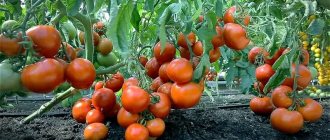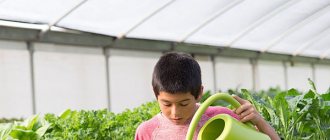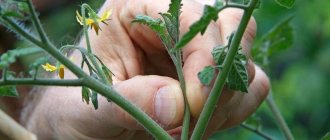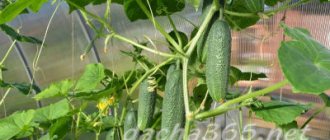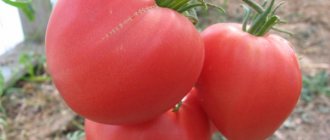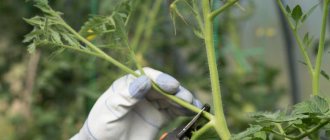Proper watering of tomatoes in film and polycarbonate greenhouses depends on compliance with a number of conditions. It is important to take into account the temperature and humidity conditions, water the plants depending on the stage of growth, and choose the most convenient method of watering. I share advice from experienced gardeners and my personal observations about all the intricacies and rules of watering tomatoes indoors.
Features of the microclimate of greenhouses
Before determining how often and correctly to water tomatoes in a greenhouse, let’s look at the features of the microclimate created inside greenhouses.
Air humidity in summer is approximately 60-80% . The exception is too hot and dry periods, when humidity drops to 40% . In this case, hot weather can alternate with rain, and then the humidity reaches 90% .
If watering in a greenhouse is improper, these indicators can be even higher, and this is detrimental to tomatoes. A feature of this crop is its requirement for moisture in the soil , but it prefers dry air for the successful development of the above-ground part. These are the conditions that need to be provided to tomatoes in the greenhouse with proper watering.
Both too much and too little watering are harmful to tomatoes . If there is too much moisture in the soil, the roots are unable to absorb it and begin to rot. Lack of moisture leads to active dehydration of foliage, and plants can overheat and die.
IMPORTANT. If you notice that the tomato leaves have begun to curl along the central vein, it means they lack moisture.
Consequences of excess moisture
Watering tomatoes too often is also quite dangerous. Here's what happens to this culture in this case:
- The leaves seem to twist outward, thereby increasing the area of the evaporating surface and getting rid of excess moisture.
- The color of the leaves becomes dull. Sometimes they can even fall off, while maintaining a juicy texture.
- So-called weeping spots appear near the root collar. Moreover, the rhizome may begin to rot.
- The fruits become limp and watery, their taste noticeably deteriorates. At some point, from excess moisture, they may even begin to burst. Accordingly, this makes them completely unsuitable for food consumption.
- One more thing. Excess fluid combined with high temperature is what contributes to the development of fungal and bacterial diseases. Therefore, before you deal with tomatoes, you need to very carefully familiarize yourself with the technology of their irrigation, and then strictly follow it, avoiding extremes.
Soil and air humidity standards for tomatoes
Watering tomatoes in a greenhouse should provide ninety percent soil moisture and fifty percent air humidity . These conditions can ensure normal growth and development of the bush, and optimal protection against fungal diseases.
How often and at what time should tomatoes be watered in a greenhouse? In order to achieve a similar microclimate in the greenhouse, watering tomatoes should be carried out subject to the following rules:
- You need to water the plants no more than once or twice a week , depending on the level of humidity and air temperature;
- each bush should receive 4-5 liters ;
- Tomatoes should be watered strictly at the root, without getting on the bush . Drops of water in the sun become a kind of lenses and cause burns;
- recommended time - morning or early evening , so that the sun does not create a greenhouse effect and all moisture goes into the soil and does not evaporate.
IMPORTANT. Do not water your tomatoes with cold water, as this will cause them stress. The water temperature should be at least 23-24 degrees.
Water requirements
To irrigate tomatoes in a greenhouse, many people use ordinary rainwater. To do this, it must be collected in some container, and then used for its intended purpose. Although some question the purity of such water. The fact is that the ecology in many parts of our planet leaves much to be desired. And trickles of rain in our time may well contain lime dust, particles of exhaust gases, etc.
Be that as it may, instead of raindrops, it is quite possible to use water from the nearest river and from the water supply. The key condition is that it should be more or less warm. Therefore, many people install tanks on their sites so that their contents can be warmed by the sun's rays. It is known that the optimal water temperature for tomatoes is from +18 °C to +25 °C.
But it’s still better not to use ice water directly from the well for irrigation. It can have a depressing effect on the root system.
Types of irrigation organization
How to water tomatoes in a greenhouse? There are several ways to organize watering tomatoes in a greenhouse:
Manual
This method is most suitable for small buildings . Using simple devices - watering cans or hoses - water is poured strictly to the root .
When watering with a hose, water often comes from a well and a water supply system, so there is a danger of hypothermia of the roots . The disadvantage of watering with a hose is the inability to control the amount of liquid per plant.
It is more advisable to organize manual watering from a watering can with settled water . To do this, it is better to place a barrel next to the greenhouse, which is filled with water in advance to heat it.
ATTENTION. If a barrel of water is placed directly in the greenhouse, be sure to cover it with a lid or plastic wrap. An open container of water in a greenhouse creates excessive air humidity, which is harmful for tomatoes.
Drip
Its organization is effective in large greenhouses , since manual watering in this case requires a lot of time and effort. It is better to simplify it by building a drip irrigation system in the greenhouse. The advantages of such irrigation are obvious:
- water goes directly to the roots without evaporating from the surface and without increasing air humidity;
- eliminates the risk of water droplets getting on the leaves, stems and flowers of plants;
- watering can be carried out at any convenient time;
- the soil is not washed away and does not become salty.
In order to organize drip irrigation of tomatoes, a special system is installed in the greenhouse to ensure the flow of moisture through special pipes to the roots . Such a system can be purchased ready-made in specialized stores or installed independently. The advantage of such watering is the additional possibility of fertilizing plants.
If it is not possible to build a drip irrigation system, you can use a very original and simple method - drip watering tomatoes in a greenhouse using plastic bottles. To do this, bottles with holes are dug into the ground next to the tomato bushes with their necks upside down. Water is poured into a bottle and gradually flows through small holes to the roots. Since one tomato plant in a greenhouse requires up to 5 liters per watering, it is better to use plastic bottles of the appropriate size.
Another option for homemade drip irrigation is to dig a tube into the ground, onto which the bottle is placed upside down. A hole is made in the bottom to fill in water. The filled bottle gradually delivers water through the tube to the roots.
Auto
Most often, this method is used in industrial greenhouses , since at the household level its cost is too high. But if the owner can afford such a structure on his site, then its use is most optimal .
Recommendations from gardeners
Many gardeners pay attention to a common mistake when watering. When a container of water is inside the greenhouse, it must be closed to prevent an increase in air humidity.
If the ground becomes quite dense in some places and the water does not penetrate deeply, it is recommended to make punctures with a pitchfork near the bushes. This will give the roots additional access to moisture and subsequently the soil will become loose.
Gardeners do not recommend immediately loosening the soil after watering. The best option is to mulch the soil. It is also not recommended to plant tomatoes and cucumbers in the same greenhouse, since they have different watering regimes and cultivation techniques.
Features of watering at different stages of tomato growth
The moisture requirement of tomatoes depends on their stage of development . Therefore, at different periods they need a special frequency of watering and the amount of moisture used.
- When planting tomato seedlings in a greenhouse, water it abundantly ( 4-5 liters per hole ) and leave for rooting for 7-10 days . Tomatoes do not need additional watering during this period.
- A week after planting, tomatoes begin to actively grow. But their root system is still weak and is not yet capable of extracting moisture from the depths of the soil. Therefore, before flowering, tomatoes are watered twice a week , spending 2-3 liters of water .
- During flowering, the amount of moisture is increased to five liters , but the frequency is reduced to once a week .
- As soon as fruits begin to appear , the frequency of watering is increased to twice a week . But you should not pour too much water under each bush, so as not to cause waterlogging of the soil and rotting of the roots.
- The signal to reduce watering is the appearance of the first tomatoes starting to turn red. During the period of fruit ripening, the procedure begins again once a week and with a small amount of water . Excessive watering during this period can lead to cracking of the fruit.
How to protect tomatoes in a greenhouse from frost
Tomatoes can be planted in the greenhouse early if you make insulated soil. To do this in the spring, in a covered or glassed greenhouse, you need to dig trenches as deep and wide as a spade. Fill the trenches with dry hay or dry leaves harvested in the fall, or even feathers (if you have a lot of old pillows or feather beds). Now you need to throw the soil dug out of the trench on top, put a board on it and walk along the board to compact the soil.
It is better to tie seedlings in a greenhouse to a horizontally stretched wire (trellis) with soft twine. Two such trellises need to be stretched. One is 10–15 cm above the tops of the transplanted seedlings, the second is right under the ceiling of the greenhouse. Under the lowest pair of leaves, you need to tie the twine with a loose loop and, wrapping the twine around the stem, pass it under each leaf, then tie it first to the lower trellis with a bow so that you can easily untie the twine.
Naturally, the length of the twine should be such that in the future you can tie the tomatoes to the upper trellis. The stem should not be allowed to bend - such a plant is poorly supplied with nutrition from the soil. As the plant grows, the twine must be constantly wound around the stem, passing it under each leaf.
Throwing non-woven material - spunbond or lutrasil - over the trellis, cover the planted tomatoes with it. It is better to make a double shelter with a thin material rather than a single and thick one.
Spunbond will protect the plantings from night frosts. The hay in the trench will begin to rot and provide heat to the tomato root system. In addition, this heat will warm the air under the spunbond. With this planting, tomatoes can withstand morning frosts down to minus 6 degrees. After the end of frost, the shelter can be removed.
In warm daytime, immediately after the end of frost, the greenhouses should be open, but the spunbond need not be removed. When the weather is warm enough, the door to the greenhouse and the vents under the roof ridge should be kept open around the clock.
Back to contents
When to water?
When and how often to water tomatoes in a greenhouse? Gardeners do not have a unanimous opinion on this issue, but it is still recommended to focus on weather conditions and the structural features of your greenhouse.
If the weather outside is warm and dry , then watering time does not matter. Especially if you do it carefully and the possibility of sunburn of the leaves is excluded. It is better to water in the afternoon , since the water is already quite warm by this hour, whereas in the morning it is still cool.
Watering late in the evening is also not recommended . Because a greenhouse closed at night creates excess air humidity, and this is harmful for tomatoes.
If watering is carried out in the evening , long-term ventilation of the greenhouse is required after it so that excess moisture evaporates and the tomatoes remain healthy.
In damp and cool weather , it is better to water the tomatoes before noon, so that the space is well ventilated during the day and excess moisture evaporates from the air.
IMPORTANT. No matter what time you perform the procedure. Leave the windows and doors open after it. If you close the greenhouse immediately after watering, the excess moisture in the air will encourage the development of fungus.
Proper organization of watering tomatoes when growing them in a greenhouse will allow you to get a large harvest of healthy and tasty fruits.
Consequences of lack of moisture
The lack of moisture slows down the nutrition process, and tomatoes begin to experience deficiency. And this has visible consequences. That is, the very appearance of the plant may indicate some problems with watering. And in this case, the gardener just needs to carefully monitor how it develops and, if anything happens, take action. If there is a lack of water, the following happens to a tomato:
- The leaves begin to curl inward. In this way, the plant tries to minimize moisture loss.
- The tomato seems to stop growing, and ovaries do not form on it in due time.
- Plants begin to get sick often.
If the fruits have already appeared by the time of the water shortage, then they either do not ripen at all or develop extremely slowly. And the taste of such fruits will ultimately be bitter and tart.
With a serious lack of moisture, the leaves turn yellow. A prolonged lack of moisture can lead to their falling off. However, both flowers and ovaries can fall off in such conditions.
It should be added that timely watering of tomatoes is especially important when it is hot outside for many days in a row. Only water in sufficient volumes will enable the plant to successfully withstand prolonged drought and save a significant part of the harvest.
